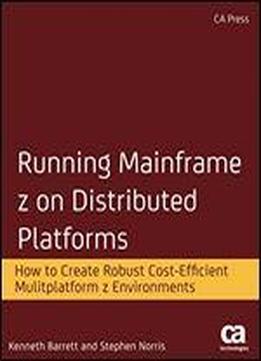
Running Mainframe Z On Distributed Platforms: How To Create Robust Cost-efficient Multiplatform Z Environments
by Kenneth Barrett /
2014 / English / EPUB
6 MB Download
"Running Mainframe z on Distributed Platforms is particularly suitable for a more detailed discussion." Bill Ogden, IBM zPDT Redbook, April 2015 "The authors offer very well-reasoned solutions accompanied by case studies, which will be useful to specialists. The book is made even more useful as the System z mainframe-based solutions offer an advanced systems management environment for significant segments of data within large companies." Eugen Petac, Computing Reviews, Oct. 8, 2014 "Should you choose to implement zPDT, RDz UT, or RD&T in your team's arsenal, you will find Barrett and Norriss insights, genius, and hard work illuminating as to how to rationally and economically manage the environment." Scott Fagen, Chief ArchitectSystem z Business, CA Technologies "A must-read for anyone interested in successfully deploying cost-efficient zPDT environments with agility in an enterprise that requires simple or complex configurations. The case-study-based exposition of the content allows for its easy consumption and use. Excellent!" Mahendra Durai, SVP & Information Technology Officer, CA Running Mainframe z on Distributed Platforms reveals alternative techniques not covered by IBM for creatively adapting and enhancing multi-user IBM zPDT environments so that they are more friendly, stable, and reusable than those envisaged by IBM. The enhancement processes and methodologies taught in this book yield multiple layers for system recovery, 24x7 availability, and superior ease of updating and upgrading operating systems and subsystems without having to rebuild environments from scratch. Most of the techniques and processes covered in this book are not new to either the mainframe or distributed platforms. What is new in this book are the authors innovative methods for taking distributed environments running mainframe virtual machine (VM) and multiple virtual storage (MVS) and making them look and feel like other MVS systems. The authors combined expertise involves every aspect of the implementation of IBM zPDT technology to create virtualized mainframe environments by which the mainframe operations on a z series server can be transitioned to distributed platforms. All of the enhancement methods consecutively laid out in this book have been architected and developed by the authors for the CA Technologies distributed platform. Barrett and Norris impart these techniques and processes to CIOs and CTOs across the mainframe and distributed fields, to zPDT and RDz UT implementers, and to IBMs independent software vendors and customers. What youll learn In particular, readers will learn from Running Mainframe z on Distributed Platforms: how to create and maintain pristine z/OS and z/VM multi-user sysplexed environments how to establish a mainframe distributed lab with repeatable processes and easy maintenance how to ensure backup/recovery integrity and business continuity standards and conventions, including the use of symbols in the system IPLs z/OS and z/VM optimizations DASD repository methodologies Who this book is for CIOs and CTOs across the mainframe and distributed fields, zPDT and RDz UT implementers, administrators and ISVs and customers. Table of Contents Understanding the Mainframe Environment, Technologies, and Methodologies Creating a Mainframe Virtualized Environment: Requirements and Choices Building the Hypervisor Host Creating a Base Environment Constructing the z/VM Environment Establishing a DASD Repository for a Multi-Server Environment Staging for z/OS Optimization Migrating to Mainframe zEnterprise DASD Customizing the z/OS Environment with Symbols Updating the Environment Preparing for Recovery Deploying Virtualized Mainframe Environments Software Licensing Setting the Standards and Conventions IEASYS Member Example LOAD Member Example Glossary











